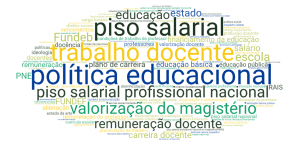ORIGINAL ARTICLE
RIBEIRO, Edivan Charlton do Nascimento [1], FECURY, Amanda Alves [2], OLIVEIRA, Euzébio de [3], DENDASCK, Carla Viana [4], DIAS, Claudio Alberto Gellis de Mattos [5]
RIBEIRO, Edivan Charlton do Nascimento. Et al. High Abilities in EPT and Regular Teaching: A Review of the Last Five Years. Revista Científica Multidisciplinar Núcleo do Conhecimento. Year. 07, Ed. 01, Vol. 04, p. 111-130. January 2022. ISSN: 2448-0959, Access link: https://www.nucleodoconhecimento.com.br/education/high-abilities-in-ept, DOI: 10.32749/nucleodoconhecimento.com.br/education/high-abilities-in-ept
ABSTRACT
School inclusion is a movement that seeks to reach people who are outside the school context due to their different condition. The term “special needs” is broad and involves many factors. According to the legislation, it is applicable to any human being who has a physical, mental, intellectual and/or sensory impairment, preventing his/her participation in daily and school life. The concept of “High Abilities / Giftedness” is still debatable. The most current, adopted by our legislation, refers to the individual’s performance in his/her area of interest, demonstrating above-average capacity. The objective of this work was to review the literature on high Abilities in EPT and regular teaching present in publications in the last five years. A bibliographic review on high Abilities /giftedness was carried out, in Portuguese, in research databases such as Scientific Electronic Library Online – SciELO and Google Scholar, between 2017 and 2021. Inclusion is a process that requires a change of attitude towards to people who are considered different. In education, this movement begins to gain ground in schools, and inclusive education slowly becomes a reality. In this context, people with AH/SD[6] indicators suffer from the same problems, with the aggravating factor of being considered students without learning difficulties (and with ease). The teaching process needs to adapt processes, materials and adequate training for all teachers. In Vocational Education, the problems regarding the identification and attendance of this public seem to be similar to the regular school and other teaching modalities.
Keywords: High Abilities, Giftedness, Inclusion, Teaching, EPT.
INTRODUCTION
The term inclusion is related to the attitude of including what is outside a certain context, group (BELL-RODRÍGUEZ, 2020). School inclusion is a movement that seeks to reach people who are outside the school context due to their different condition. Not only its insertion, but the offer of conditions for its total development, breaking physical barriers, attitudes, preconceptions and/or architectural (physical access structure) (MANTOAN, 2003).
In Brazil, after the mobilization of groups and entities in favor of people’s rights and dignity, inclusion is guaranteed by legislation. In education, it is carried out by insertion in a regular classroom. In order for learning to be guaranteed, this student is offered, in the counter shift, specialized service, aiming to meet their needs. However, there still seems to be a lot to structure in the school space, in all areas, to make this process better consolidated (SILVA and CARVALHO, 2017).
People with disabilities, according to the legislation, are those prevented for physical, mental, intellectual or sensory reasons from participating fully in social life on an equal basis with other people (BRASIL, 2015).
The term “special needs” is broad and involves many factors. According to the legislation, it is applicable to any human being who has a physical, mental, intellectual and/or sensory impairment, preventing his/her participation in daily and school life. They are restrictions and limitations that affect the full development of the person, involving all aspects of their daily life. Within the school context, it is related to a differentiation in the pace of learning from what is considered normal. Anyone who is outside this standard is framed in this term, either because of the difficulty or ease of learning (CNE/CEB, 2009; BRASIL, 2015).
The definition of intelligence can be complex and multifaceted. It is beyond answering something correctly, relating or abstracting content. It is something inherent to the person and is influenced by the environment in which they live and their genetics. It is not restricted to the school context, but to performance in several other areas, such as artistic and interpersonal relationships (NISTA-PICCOLO et al., 2018).
The concept of “High Abilities /Gifted” is still debatable. The most current, adopted by our legislation, refers to the performance of the individual in their area of interest, demonstrating above-average capacity, creativity, involvement in learning. It covers the academic, intellectual, creative, leadership and/or other areas (MARTELLI, 2017).
To identify people with indicators of high abilities/giftedness, tests that seek to “measure” intelligence (intelligence quotient – IQ) are still widely criticized for limiting or privileging certain areas of knowledge. With the change in the perception of what intelligence is, where other potentials are observed, the behavioral characteristics scales are used. In Brazil, the most used scale is the Renzulli scale. It measures three groups of behaviors: interest, commitment and creativity (PÉREZ, 2009).
The Nucleus for Assistance to People with Specific Educational Needs (NAPNE)[7] was created to serve students with special educational needs enrolled in the networks of federal institutes. It is your responsibility to implement and operate within the perspective of inclusive education and respect for differences. It must create conditions for entry, permanence and completion in its courses for the target audience of inclusive education students. This type of nucleus was conceived by the Ministry of Education MEC[8] through the Secretariat of Vocational and Technological Education of the Ministry of Education (SETEC/MEC) (IFRN, 2021).
Technical and technological education is integrated into the education system and, therefore, is linked to the laws that govern it. People with indicators of high abilities/giftedness, with their particularities, are included in the inclusive education policy and, due to this situation, they need specialized educational assistance. Special education takes place at all levels, stages and teaching modalities, so Vocational and Technological Education cannot avoid serving this public, seeking to develop its full potential by implementing, through its NAPNEs, service policies (BRASIL, 2008).
OBJECTIVE
Make a literature review on high Abilities in EPT and regular teaching present in publications in the last five years.
METHOD
A bibliographic review was carried out on high abilities/giftedness, in Portuguese, in research databases such as Scientific Electronic Library Online – SciELO and Google Scholar, between 2017 and 2021. For this, the keywords (or descriptors) were used. “High Abilities and Education”, “High Abilities and Teaching”, “Giftedness and Education”, “Giftedness and Teaching”, “High Abilities and Technological Vocational Education”, “Giftedness and Technological Vocational Education”. This makes it possible for the review to be based on the most up-to-date academic productions (CAPES, 2012).
As inclusion criteria, articles with content that combined High Abilities /Giftedness with education, teaching and/or Vocational and Technological Education (EPT) were used within the review period. Articles that did not meet this content and/or period of time were excluded.
RESULTS AND DISCUSSION
The results and conclusions of the researched articles are listed below, with their respective discussions.
Table 1 shows the number of articles found by searched descriptor and the number of articles used in the review. It also shows the authors and years of publications used.
Table 1 – Number of articles found and used, according to each descriptor, and their respective authors and years
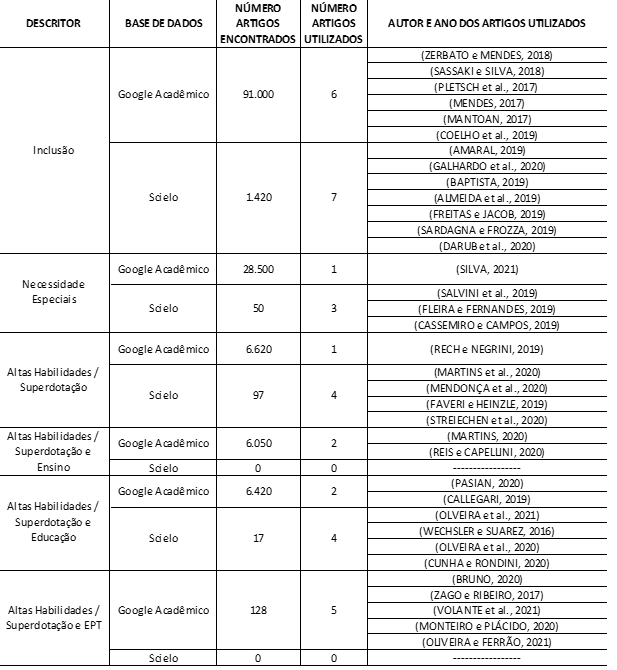
The results and conclusions of the articles on the descriptor “inclusion” with method, author and year of each article are shown in table 2.
Table 2 – Results and conclusions of articles on the descriptor “inclusion” with method, author and year of each article
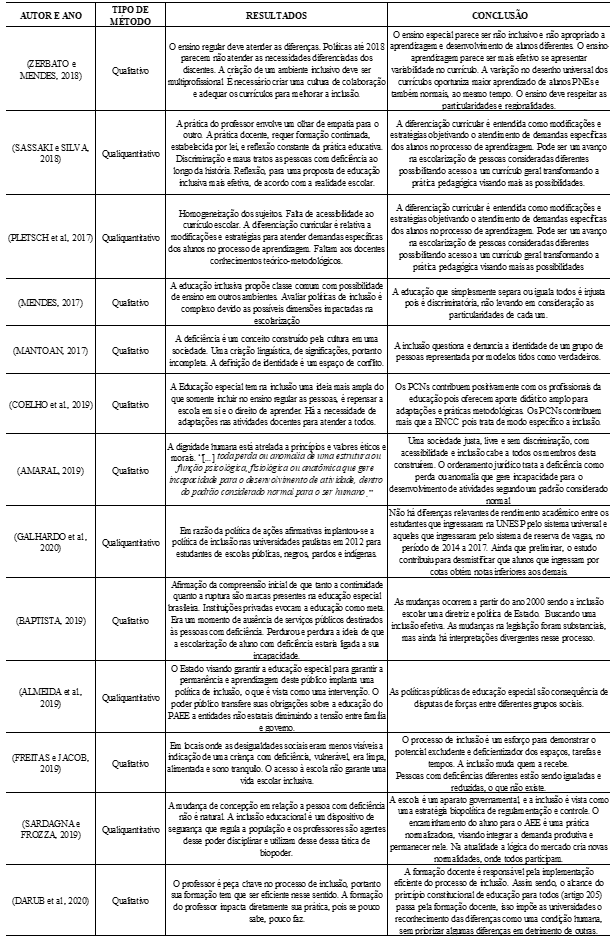
Inclusive education aims to welcome, promote the development and learning of all its students, in a democratic way, therefore intended for all (OLIVEIRA et al., 2020). Public policies guarantee the inclusion of the Target Audience of Special Education (PAEE) in the regular education network, but it is believed that there are other difficulties for this effect. As much as teachers believe in inclusion, the school space seems to be just for the socialization of this public. This reflects on the learning of functional skills and not formal content, restricting their teaching and knowledge. As a consequence, students with school delay are observed (WEIZENMANN et al., 2020).
The student has the right to be adequately served in the school environment and according to inclusive education, everyone should learn together. This requires the use of curricular adaptations as an instrument that guarantees respect for differences in the teaching and learning process, and can improve general development through strategies, objectives and in its evaluation. Schools need to direct their work respecting individual diversities, such as the pace of learning, and ensuring quality education for all. To make a school environment inclusive, curricular adaptations must be carried out covering the particularities of each student, teaching resources, assessment practices, methodologies and other means for truly effective learning. However, these actions are carried out with valued professionals, continuing education that empowers them, pedagogical support, adequate rooms, reduced numbers of students and multifunctional resource rooms (BERTOLDE and LARCHERT, 2020).
Teacher training appears as one of the problems of current education, reflecting on teaching. In addition to training, other obstacles are mentioned, such as the inadequacy of the physical structure of schools, students without diagnoses and the lack of knowledge of what inclusive education is. For the teaching role to be developed with quality, technical and personal competence is necessary. School inclusion requires everyone to adapt to the diversity of students, which implies personalized attention, creating opportunities for everyone’s development (FERREIRA and TOMAN, 2020; WEIZENMANN et al., 2020).
The National Curricular Common Base (BNCC) and the National Curriculum Parameters (PCN) are reference documents in education and guide teaching practice. In special education, PCNs have the objective of adapting the curriculum seeking an appropriate education. Because it is specific to better guide teaching practice and the school environment. The BNCC, on the other hand, does not show commitment and is more comprehensive with special education and inclusion, not observing the necessary training of the education professional and transferring this commitment to each school through its pedagogical project (LIMA, 2020).
National legislation defines Specialized Educational Service (AEE)[9] as a set of activities, pedagogical resources, and accessibility, organized in an institutional and continuous manner for the PAEE. The service takes place in a complementary way for students with disabilities and pervasive developmental disorders, and in a supplementary way for those with high abilities/giftedness. These modalities point to the technical and instrumental character of these specialized services, and adequate teacher training can contribute to successful practices with these students. When accessing the AEE, students with an age/grade gap may reject this service. Even so, the AEE can act as a support tool providing a higher level of learning, which is favorable to the participation of this public in regular schools (JUNIOR and CIA, 2021).
It is necessary to understand who is legally entitled to special education. According to the legislation, students considered to have special needs are those with disabilities (with long-term impairment), those with global developmental disorders and those with high abilities/giftedness. Although legally restrictive, it is an advance, and the benefits have already been pointed out by studies (OLIVEIRA et al., 2020).
Table 3 – Results and conclusions of articles on the descriptor “special needs” with method, author and year of each article
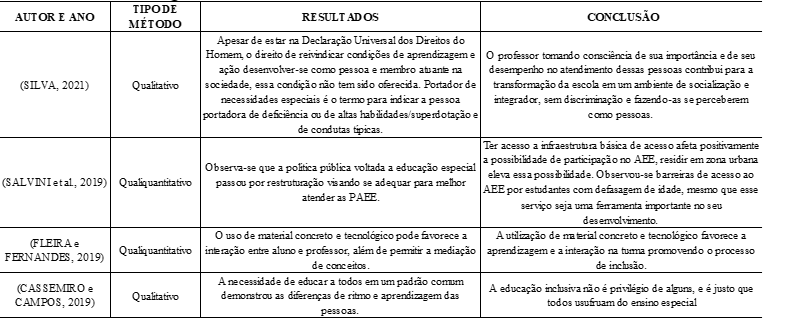
Every student has the right to a quality education and care at school with or without special needs. In this sense, Mantoan states that “[…] each and every student deserves a school capable of offering them the conditions to learn, living with differences, and which values what they can understand about the world and themselves” ( OLIVEIRA et al., 2020). Therefore, Inclusive Education can be considered a school concept that aims to develop educational responses that reach all students (RODRIGUES et al., 2020).
Law 9394/96 guarantees basic education for the rural population with the necessary adaptations to their reality, from their own curricular organization to a differentiated school calendar. Despite this guarantee, rural education is a group that historically suffers from exclusion and has specific characteristics that must be respected. In this sense, rural education and inclusive education are similar because they aim for the student to have access to quality education that allows him to act critically in society, but that does not impose a reality on him and that respects and values differences (RODRIGUES et al. , 2020).
According to the School Census, an age/grade gap is considered to be the difference of two years, or more, between the age of the student and the grade they should be attending (SANTOS and SANTOS, 2020). The distortion seems to be linked to failure rates of students and dropout from studies. The lack of investments and research makes it difficult to ensure equity and maintain the student in the correct grade (FERREIRA and TOMAN, 2020). There is a setback in education policy in the countryside, which can increase these distortions in rural areas and traditional communities (SANTOS and SANTOS, 2020).
Inclusion is a process in which the school and society seek to value differences, abilities and the use of different resources for the development of the person. The use of technologies can be a great ally for inclusive education, as it is a tool that creates teaching and learning opportunities in different situations, mediating the development of each one’s potential (BONNER et al., 2021).
The teacher, in the context of inclusion, acts as a mediator who stimulates the learning process of all students, who can grow as citizens and perform their tasks with quality for their personal and professional growth. In this context, it is the professional of difference, but it is necessary for him to understand and engage with the cause, as he is a key player in the perspective of inclusive education (JESUS et al., 2019).
Table 4 shows the results and conclusions of articles on the descriptor “high Abilities / giftedness” with method, author and year of each article
Table 4 – Results and conclusions of articles on the descriptor “high Abilities / giftedness” with method, author and year of each article
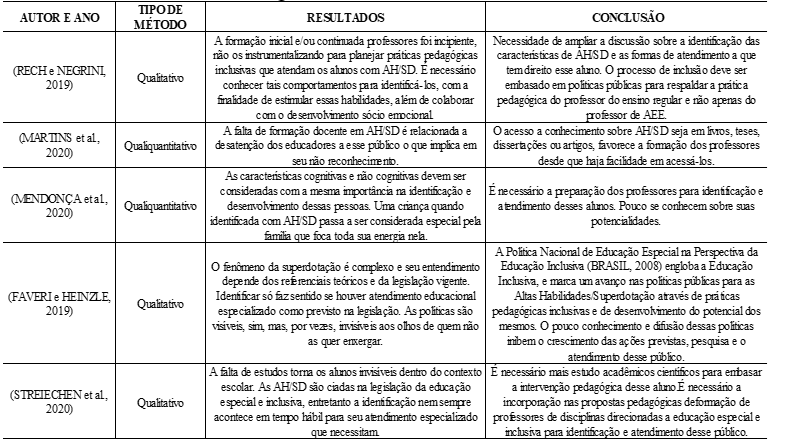
The articles found using the descriptors “High Abilities / Giftedness and Teaching” and “High Abilities / Giftedness and Education”, their authors and years, are shown in table 5.
Table 5 – Results and conclusions of articles on the descriptors “High Abilities / Giftedness and Teaching” and “High Abilities / Giftedness and Education”, with method, author and year of each article
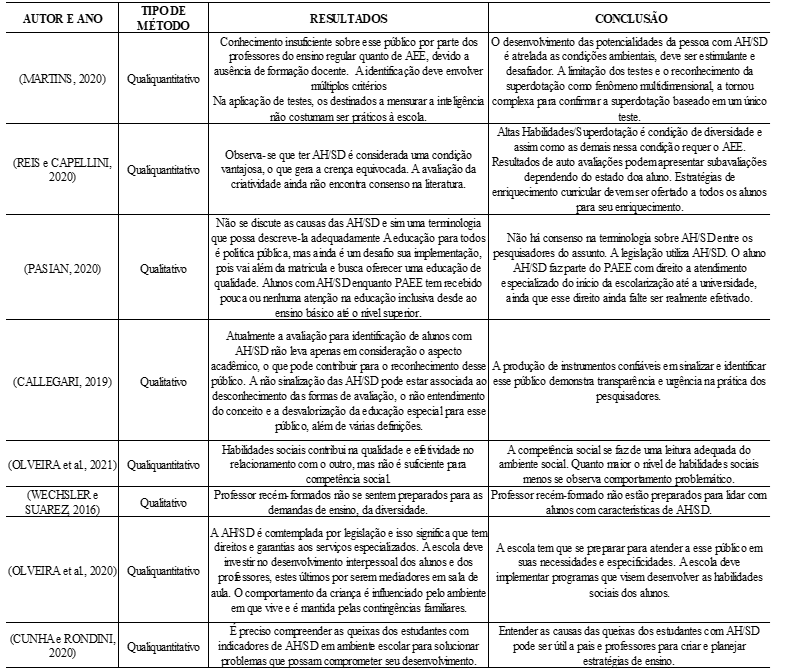
People with High Abilities/Giftedness (AH/SD), according to the National Policy for Inclusive Education, are those who are characterized by high performance and/or high potential in isolated or combined aspects. They may have increased general intellectual capacity, specific academic aptitude, creative and/or productive thinking, leadership ability, special talent for the arts, psychomotor ability, and great involvement with task and learning in areas of interest (REMOLI et al., 2020). Studies on this topic demonstrate the existence of myths, which still persist in society, such as the one that says that AH/SD do not need assistance because they learn quickly. This makes their identification difficult and leaves them on the sidelines in this process (FREITAS and FERREIRA, 2021). The presence of AH/SD indicators points to the need for specialized educational care that respects their particularities and develops their potential, hence the need for identification, but without losing the characteristics of early childhood education development (OLIVEIRA, 2020).
In the state of Amapá, this service has been provided, since 2006, by the High Abilities and Giftedness Center (CAAH/SD)[10], by a multidisciplinary team (GOVAP, 2016). The objective, in compliance with the legislation, is to guide and support the education system for students with these detected characteristics (SEED, 2020).
Special education aimed at AH/SD contains challenges such as cognitive, social and emotional needs and combating myths related to students. Facing them requires training from the teacher that supports him/her, in addition to providing adequate spaces and materials to serve this audience. It is necessary to develop techniques for their identification and necessary adjustments for their care. Teacher training should involve technical-methodological procedures related to planning, it should involve the teacher/student relationship and use mediation of didactic resources (DRULIS and SALES, 2021). Schools and professionals need to be prepared to intervene so that the needs of students are addressed (SANTOS, 2020).
The education system presents difficulties to deal with this public. The lack of identification of their condition contributes to the non-compliance and appreciation of their needs (MARTELLI and MOREIRA, 2021). One possibility of service in the school space, which is considered a place of formal learning, with its rules and requirements, is the presence of multifunctional rooms, where service can be carried out individually or in small groups, according to the characteristics of each one, using materials and planning consistent with it (ESPANHOL, 2020).
The term AH/SD raises the question of identification and what it is to be intelligent. This generates many discussions, with opposing views: one of a happy, secure, successful and adapted person. The other of a difficult, anxious, troubled and sensitive person. Which demonstrates a lack of knowledge about this audience. These students suffer from the lack of identification of their condition, and this leads to the failure to meet their educational needs and the development of their potential (MARTELLI and MOREIRA, 2021).
Table 6 shows the results and conclusions of articles on the descriptor “high Abilities / giftedness and EPT” with method, author and year of each article.
Table 6 – Results and conclusions of articles on the descriptor “high Abilities / giftedness and EPT” with method, author and year of each article
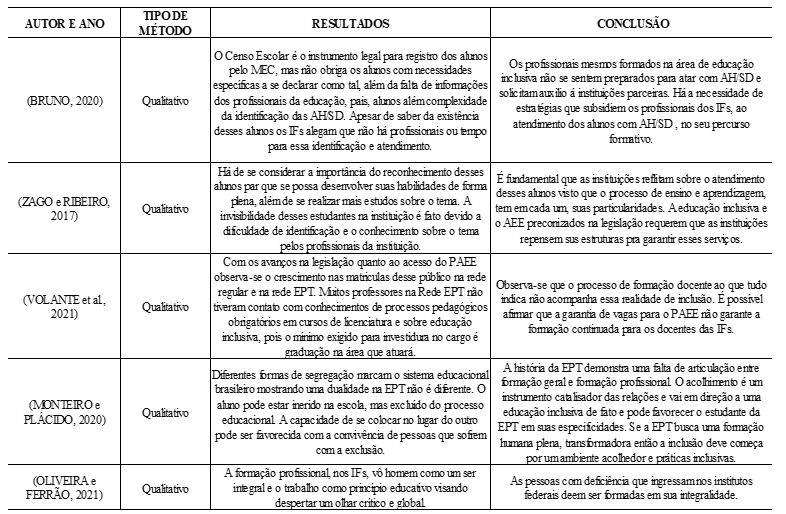
The Federal Institutes (IFs) are part of the Federal Education Network in the form of Vocational and Technological Education. Special Education works at all levels and modalities of education, whether public or private, and these institutions must make adjustments that allow this public access to vocational education and the world of work. In this context, the Service Center for People with Specific Educational Needs (NAPNE) was created in the IFs, whose mission is to articulate strategies that develop the successful entry, stay and exit of PAEE students for higher education and/or higher education or for the job market (FRANCO and VILARONGA, 2021).
According to decree nº10502 of September 30, 2020, NAPNE has space in the IFs and is now understood as support and not necessarily as service to this public, while it continues to be listed as a resource and specialized service. This center focuses on the student community, but also guides teachers and conducts activities that contribute to teacher training. It also helps managers to make decisions related to issues involving the public of inclusive education (FRANCO and VILARONGA, 2021).
Many teachers responsible for technical disciplines of professional training join the teaching staff of IFs through a competitive examination, even without teacher training in licensure, due to legal authorization that supports and compares technical knowledge with it. This lack of pedagogical knowledge can make it difficult to create teaching strategies that aim to guarantee the right of PAEE students. In this sense, the support provided by NAPNEs stands out in the context of the Technological Professional Network (FRANCO and VILARONGA, 2021). This lack of pedagogical knowledge can be corrected through continued training of teachers, which may take place at their workplace or at a basic or higher education institution (SANTOS et al., 2020).
There is still a long way to go for the NAPNEs to fulfill their creation proposal, as there are still several differences between each of them. There were advances in the creation of a culture of coexistence, respect for differences, architectural accessibility, and elimination of attitudinal and educational barriers through education. Actions to modernize accessibility in older FIs and ensuring this accessibility in new constructions exemplify these advances (VILARONGA et al., 2021).
CONCLUSIONS
Inclusion is a process that requires a change in attitude towards people who are considered different and who, for a long time, were separated from social life, causing harm to them. This can be observed in the learning process and in the emotional consequences that affect the individual. This situation is beginning to change, but there is still a long way to go.
In education, this movement begins to gain ground in schools, and inclusive education slowly becomes a reality. Even so, despite being a beginning, it is still excluding, as the students included are equal to the others, which does not take into account their particularities, causing more problems than solutions, reinforcing prejudices.
In this context, people with AH/SD indicators suffer from the same problems, with the aggravating factor of being considered students without learning difficulties (and with ease). They are left on the sidelines demonstrating the weaknesses of the school system in relation to them. Materials and methodologies suitable for the development of its potential are absent or fragile. The identification process for care is flawed and there is a lack of knowledge of the current legislation that guides special education.
The teaching process needs to adapt processes, materials and adequate training for all teachers. Easier access to information about the target audience of special education can improve identification, service and make the process of inclusion of AH/SD students more concrete.
In Vocational Education, the problems regarding the identification and attendance of this public seem to be similar to the regular school. With its particularities, there is still a need for curricular adaptations and adequate training of teachers, which would guarantee the permanence and successful exit of their courses, preparing the student for a possible entry into the world of work or universities. The NAPNE seems to play a fundamental role in this process, as well as the centers specialized in other teaching modalities.
Conducting more studies and research on the AH/SD public, both in regular schools and in technological institutes, seems to be necessary for an improvement in the identification and care of these students.
REFERENCES
ALMEIDA, M. L.; MELO, D. C. F.; FRANÇA, M. G. Repercussão da política nacional de educação especial no Espírito Santo nos últimos dez anos. Educ. Pesqui., v. 45, p. 1-17, 2019. Disponível em: < https://www.scielo.br/j/ep/a/SRdF9dyLhBFP3bmsWdWgDbc/?format=pdf&lang=pt >.
AMARAL, L. C. Pessoa com deficiência: inclusão, acessibilidade na sociedade contemporânea. LEGIS, v. 12, n. 1, p. 33-51, 2019. Disponível em: < https://revistas.unisuam.edu.br/index.php/legisaugustus/article/view/444/197 >.
BAPTISTA, C. R. Política pública, Educação Especial e escolarização no Brasil. Educ. Pesqui, v. 45, p. 1-19, 2019.
BELL-RODRÍGUEZ, R. F. Comprensión del ciclo para la inclusión educativa en la educación superior ecuatoriana. Revista Electrónica Educare (Educare Electronic Journal), v. 24, n. 1, p. 1-21, 2020.
BERTOLDE, F. Z.; LARCHERT, J. M. Pensando As Adaptações Curriculares Na Perspectiva Da Educação Especial. In: CASTRO, P. A. D. (Ed.). Educação como (re)existência: Mudanças, conscientização e conhecimentos Campina Grande PB: Editora Realize, v.1, 2020. p.1312-1329.
BONNER, I. C. S.; GONÇALVES, M. J.; SOUZA, P. V. V. Tecnologia e revistas em quadrinhos no trabalho da inclusão. Humanidades & Inovação, v. 8, n. 35, p. 229-239, 2021.
BRASIL. LEI Nº 11.741, DE 16 DE JULHO DE 2008. CASA_CIVIL. Brasília DF: Presidência da República 2008.
______. LEI Nº 13.146, DE 6 DE JULHO DE 2015. SECRETARIA-GERAL. Brasília DF: Presidência da República 2015.
BRUNO, G. S. N. Desafio escolar na Educação Profissional e Tecnológica: Estratégias de atuação com alunos com Altas Habilidades/Superdotação. In: SONZA, A. P. (Ed.). Afirmar : a inclusão e as diversidades no IFRS : ações e reflexões. Bento Gonçalves RS: IFRS, v.1, 2020. p.191-201.
CALLEGARI, B. Adaptação e evidências de validade de conteúdos das escalas para avaliação das características comportamentais de estudantes com habilidades superiores. 2019. 152p. (Mestrado). UNESP, Bauru SP.
CAPES. Treinamento no uso do Portal de Periódicos. Brasilia DF, 2012. Disponível em: < https://www.fca.unesp.br/Home/Biblioteca/portal-capes.pdf >. Acesso em: 06 set 2021.
CASSEMIRO, M. F. P.; CAMPOS, R. H. F. Formação de Professores para a Educação Especial – Propostas de Helena Antipoff e seus Colaboradores na Fazenda do Rosário nos Anos de 1960. Revista Brasileira de Educação Especial, v. 25, n. 2, p. 337 – 354, 2019.
CNE/CEB. Resolução Nº 4, De 2 de Outubro de 2009. Brasília DF: MEC: 1-3 p. 2009.
COELHO, C. P.; SOARES, R. G.; ROEHRS, R. Visões Sobre Inclusão Escolar No Contexto De Educação Especial: PCN X BNCC. Revista Educação E Políticas Em Debate, v. 8, n. 2, p. 158-174, 2019.
CUNHA, V. A. B.; RONDINI, C. A. Queixas Escolares Apresentadas Por Estudantes Com Altas Habilidades / Superdotação: Relato Materno. Psicologia Escolar e Educacional, v. 24, p. 1-10, 2020.
DARUB, A. K. G. S.; SOARES, L. G. C.; SANTOS, P. K. Formação docente inicial e as discussões sobre a inclusão. Análise do currículo do curso de pedagogia de uma universidade pública da região norte do Brasil InterCambios. Dilemas y transiciones de la Educación Superior, v. 7, n. 1, p. 43 – 53, 2020.
DRULIS, P. B. L.; SALES, A. Organização Do Trabalho Didático Em Atendimento Às Altas Habilidades/Superdotação. REIN-Revista Educação Inclusiva, v. 5, n. 1, p. 14-23, 2021.
ESPANHOL, F. C. S. Propostas de atividades em grupo para estudantes com altas habilidades/superdotação. Revista Diálogos e Perspectivas em Educação Especial, v. 7, n. 1, p. 23-36, 2020.
FAVERI, F. N. M.; HEINZLE, M. R. S. Habilidades/Superdotação: políticas visíveis na educação dos invisíveis. Revista Educação Especial, v. 32, p. 1-23, 2019.
FERREIRA, G. C.; TOMAN, A. Educação especial e inclusão: O que mostram as iniciativas de formação continuada? REDOC, v. 4, n. 3, p. 1-20, 2020.
FLEIRA, R. C.; FERNANDES, S. H. A. A. Ensinando Seus Pares: a inclusão de um aluno autista nas aulas de Matemática Bolema, v. 33, n. 64, p. 811-831, 2019.
FRANCO, A. B. M.; VILARONGA, C. A. R. O contexto da inclusão escolar nos Institutos Federais e no Ensino Médio integrado. Revista Cocar, v. 15, n. 33, p. 1-21, 2021.
FREITAS, K. R.; FERREIRA, S. P. O núcleo de atividades de altas habilidades/superdotação na perspectiva de uma psicóloga. Brazilian Journal of Development, v. 7, n. 2, p. 17217-17230, 2021.
FREITAS, M. C.; JACOB, R. N. F. Inclusão educacional de crianças com deficiências: notas do chão da escola Educ. Pesqui, v. 45, p. 1-20, 2019.
GALHARDO, E. et al. Desempenho acadêmico e frequência dos estudantes ingressantes pelo Programa de Inclusão da UNESP. Avaliação, v. 25, n. 3, p. 701-723, 2020.
GOVAP. Centro de Altas habilidades comemora 10 anos de implantação no Amapá. Macapá AP, 2016. Disponível em: < https://www.portal.ap.gov.br/noticia/1705/centro-de-altas-habilidades-comemora-10-anos-de-implantacao-no-amapa >. Acesso em: 05 dez 2021.
IFRN. NAPNE – Núcleo de Atendimento às Pessoas com Necessidades Educacionais Especiais. Natal RN, 2021. Disponível em: < https://portal.ifrn.edu.br/campus/natalcentral/nucleo-de-inclusao >. Acesso em: 06 set 2021.
JESUS, M. J. G.; OLIVEIRA, K. F.; PEDROSA, R. Educação inclusiva: O papel do professor e a intervenção do psicologo neste contexto. Revista Cefop Fapaz De Educação, Cultura, Ciência E Tecnologia, n. 1, p. 10-22, 2019.
JUNIOR, V. S. J.; CIA, F. Percepções dos familiares de estudantes público-alvo da Educação Especial sobre o Atendimento Educacional Especializado. Revista Educação Especial, v. 34, 2021.
LIMA, H. C. N. BNCC x PCN: Inclusão escolar no contexto de educação especial. IV CINTEDI. Campina Grande PB: UEPB: 1-12 p. 2020.
MANTOAN, M. T. E. Inclusão escolar : o que é? por quê? como fazer? São Paulo SP Moderna 2003. 51p. Disponível em: < https://files.cercomp.ufg.br/weby/up/211/o/INCLUS%C3%83O-ESCOLARMaria-Teresa-Egl%C3%A9r-Mantoan-Inclus%C3%A3o-Escolar.pdf >.
MANTOAN, M. T. E. Inclusão, diferença e deficiência: sentidos, deslocamentos, proposições. Inclusão Social, v. 10, n. 2, p. 37-46, 2017. Disponível em: < http://revista.ibict.br/inclusao/article/view/4030 >.
MARTELLI, A. C. C. P. Políticas Educacionais Para Estudantes Com Altas Habilidades/Superdotação: Um Estudo Sobre A Transversalidade. 2017. 161p. (Mestrado). Universidade Federal do Paraná, Curitiba PR.
MARTELLI, A. C. C. P., E.; MOREIRA, L. C. A Transversalidade Das Políticas Educacionais Para Estudantes Com Altas Habilidades/Superdotação. Teoria E Prática Da Educação, v. 24, n. 1, p. 42-57, 2021.
MARTINS, B. A. Escala de Identificação de Precocidade e Indicadores de Altas Habilidades/Superdotação (EIPIAHS): um instrumento em construção. Revista Educação Especial, v. 33, p. 1-25, 2020.
MARTINS, B. A.; CHACON, M. C. M.; ALMEIDA, L. S. Altas Habilidades/Superdotação na formação de professores brasileiros e portugueses: Um estudo comparativo entre os casos da UNESP e da UMINHO. Educação em Revista, v. 36, p. 1-20, 2020.
MENDES, E. G. Sobre alunos “incluídos” ou “da inclusão”: reflexões sobre o conceito de inclusão escolar. In: VICTOR, S. L.;VIEIRA, A. B., et al (Ed.). Educação especial inclusiva: Conceituações, medicalização e políticas. Campos dos Goytacazes RJ Brasil Multicultural., 2017. p.60-83.
MENDONÇA, L. D.; RODRIGUES, O. M. P. R.; CAPELLINI, V. L. M. F. Alunos com altas habilidades/superdotação: como se veem e como são vistos por seus pais e professores. Educar em Revista, v. 36, p. 1-22, 2020.
MONTEIRO, C. M. A.; PLÁCIDO, R. L. O acolhimento nas práticas educacionais inclusivas da EPT Educ. foco, v. 25, n. 3, p. 84-106, 2020.
NISTA-PICCOLO, V. L.; SILVA, Y. M. D.; MELLO, F. L. D. A inteligência humana e o cotidiano escolar. Série-Estudos, v. 23, n. 47, p. 27-41, 2018. Disponível em: < https://serieucdb.emnuvens.com.br/serie-estudos/article/view/1114/pdf >.
OLIVEIRA, I. T. T.; FEITOSA, F. S.; MOTA, J. S. Inclusão Escolar De Alunos Com Necessidades Especiais: Desafios Da Prática Docente. Revista Humanidades e Inovação, v. 7, n. 8, p. 81-95, 2020.
OLIVEIRA, M. C. C. Revisão bibliográfica: A importância de medidas adequadas para o desenvolvimento de pessoas com altas habilidades/superdotação. IV CINTEDI. Campina Grande PB UEPB: 1-7 p. 2020.
OLIVEIRA, S. C. S.; FERRÃO, T. S. Os caminhos da Inclusão das pessoas com deficiência: a evolução até a educação profissional e tecnológica da Rede Federal. Research, Society and Development, v. 10, n. 12, p. e504101220702, 2021.
OLVEIRA, A. P. et al. Habilidades Sociais e Problemas de Comportamento de Crianças com Altas Habilidades/Superdotação. Psicologia: Ciência e Profissão, v. 41, p. 1-17, 2021.
OLVEIRA, A. P.; FIALHO, V. L. M.; RODRIGUES, O. M. P. R. Altas Habilidades/Superdotação: Intervenção em Habilidades Sociais com Estudantes, Pais/Responsáveis e Professoras. Revista Brasileira de Educação Especial, v. 26, n. 1, p. 125-142, 2020.
PASIAN, M. S. Alunos com Altas Habilidades /Superdotação na Educação Especial: Terminologia e Origem. Cadernos da Fucamp, v. 19, n. 42, p. 48-55, 2020.
PÉREZ, S. G. P. A identificação das altas habilidades sob uma perspectiva multidimensional. Revista Educação Especial, v. 22, n. 35, p. 299-328, 2009.
PLETSCH, M. D.; SOUZA, F. F.; ORLEANS, L. F. A diferenciação curricular e o desenho universal na aprendizagem como princípios para a inclusão escolar. Revista Educação e Cultura Contemporânea, v. 14, p. 264-261, 2017.
RECH, A. J. D.; NEGRINI, T. Formação de professores e altas habilidades/superdotação: um caminho ainda em construção. RIAEE–Revista Ibero-Americana de Estudos em Educação, v. 14, n. 2, p. 485-498, 2019.
REIS, V. L.; CAPELLINI, V. L. M. F. Altas habilidades/superdotação e criatividade em estudantes do ensino médio: identificação por instrumentos de auto avaliação Revista Ibero-Americana de Criatividade e Inovação, v. 1, n. 2, p. 107-122, 2020.
REMOLI, T. C. et al. Programa para desenvolvimento da criatividade a alunos com e sem altas habilidades/superdotação. Psic. da Ed., v. 50, p. 73-83, 2020.
RODRIGUES, T. D. et al. Compreensões sobre Educação no Campo no âmbito da Educação Inclusiva e da Educação Matemática: o contexto de duas pesquisas. Boletim GEPEM, n. 76, p. 170 – 183, 2020.
SALVINI, R. R. et al. Avaliação do Impacto do Atendimento Educacional Especializado (AEE) sobre a Defasagem Escolar dos Alunos da Educação Especial. Estudos Econômicos v. 49, n. 3, p. 539 – 568, 2019.
SANTOS, D. V. G.; FERRETE, A. A. S. S.; SANTOS, L. A. M. Análise Da Produção Científica Acerca Da Formação Continuada De Docentes Dos Institutos Federais. Revista Brasileira Da Educação Profissional E Tecnológica, v. 1, p. 1 -19, 2020.
SANTOS, K. V. G. Práticas Pedagógicas De Professores Das Salas De Recursos De Altas Habilidades/Superdotação Do Distrito Federal Segundo A Teoria De Joseph Renzulli. 2020. 152p. (Mestrado). Universidade De Brasília, Brasília DF.
SANTOS, V. P.; SANTOS, A. R. Relação Entre A Distorção Idade-Série Nas Escolas Do Campo E As Políticas De Avaliação. Revista de Estudos em Educação e Diversidade, v. 1, n. 2, p. 166-184, 2020.
SARDAGNA, H. V.; FROZZA, T. F. Narrativas e Práticas de Governamentalidade: A Perspectiva do Docente sobre o aluno com deficiência. Educação em Revista, v. 35, p. 1-23, 2019.
SASSAKI, O. M. S.; SILVA, E. S. Inclusão escolar: um saber necessário à prática docente? Rev. NEaD-Unesp, v. 4, n. 1, p. 86-112, 2018.
SEED. NTE 28 Live recebe o Centro de Atividades em Altas Habilidades/ Superdotação do Amapá. Macapá ap, 2020. Disponível em: < http://portal.educacao.rs.gov.br/Main/Noticia/Visualizar/portalseduc/NTE-28-Live-recebe-o-Centro-de-Atividades-em-Altas-Habilidades-Superdotacao-do-Amapa-1 >. Acesso em: 05 dez 2021.
SILVA, M. M. P. Contexto Educacional da Criança Portadora de Necessidades Educativas Especiais: A Importância do Professor. Revista Saber Digital, v. 1, n. 1, p. 154-161, 2021.
SILVA, N. C.; CARVALHO, B. G. E. Compreendendo o Processo de Inclusão Escolar no Brasil na Perspectiva dos Professores: uma Revisão Integrativa. Rev. Bras. Ed. Esp., v. 23, n. 2, p. 293-308, 2017.
STREIECHEN, E. M.KRAUSE-LEMKE, C.; CRUZ, G.C. Análise do percurso escolar de um estudante com altas habilidades em um contexto familiar multilíngue: um estudo de caso. Revista Brasileira de Educação, v. 25, p. 1-18, 2020.
VILARONGA, C. A. R. et al. Inclusão escolar e atuação dos Núcleos de Apoio às Pessoas com Necessidades Educacionais Específicas no Instituto Federal de São Paulo. Revista Brasileira de Estudos Pedagógicos, v. 102, p. 283-307, 2021.
VOLANTE, D. P.; COSTA, L. U.; CORDEIRO, U. P. R. L. A Rede EPT na perspectiva inclusiva: uma revisão sistemática da literatura sobre formação continuada docente. Cadernos de Aplicação, v. 34, n. 2, p. 1-23, 2021.
WECHSLER, S. M.; SUAREZ, J. T. Percepção de professores em cursos de formação sobre Talentos/superdotação. Revista de Psicología (PUCP), v. 34, n. 1, p. 39 – 60, 2016.
WEIZENMANN, L. S.; PEZZI, F. A. S.; ZANON, R. B. Inclusão Escolar E Autismo: Sentimentos E Práticas Docentes. Psicologia Escolar e Educacional, v. 24, p. 1-8, 2020.
ZAGO, C. R.; RIBEIRO, E. A. W. Altas habilidades/superdotação e o atendimento educacional especializado na educação profissional, técnica e tecnológica: desafios e perspectivas. Revista Dynamis, v. 23, n. 1, p. 95-111, 2017.
ZERBATO, A. P.; MENDES, E. G. Desenho universal para a aprendizagem como estratégia de inclusão escolar. Educação Unisinos, v. 22, n. 2, p. 147-155, 2018.
APPENDIX – FOOTNOTE
6. Altas habilidades/Superdotação (AH/SD).
7. Núcleo de Atendimento às Pessoas com Necessidades Educacionais Específicas (NAPNE).
8. Ministerio da Educação (MEC).
9. Atendimento Educacional Especializado (AEE).
10. Centro de Atividades de Altas Habilidades e Superdotação (CAAH/SD).
[1] Physicist with specialization in Mathematics, Specialist in Higher Education Teaching (CETE) and in Technologies in Education (PUC RJ). Student of the Graduate Program in Professional and Technological Education (PROFEPT IFAP).
[2] Biomedical, Doctor in Tropical Diseases, Professor and researcher at the Macapá Campus Medicine Course, Federal University of Amapá (UNIFAP).
[3] Biologist, Doctor in Tropical Diseases, Professor and researcher at the Physical Education Course at the Federal University of Pará (UFPA).
[4] PhD in Psychology and Clinical Psychoanalysis. PhD in progress in Communication and Semiotics from the Pontifical Catholic University of São Paulo (PUC/SP). Masters in Religious Sciences from Universidade Presbiteriana Mackenzie. Master in Clinical Psychoanalysis. Degree in Biological Sciences. Degree in Theology. He has been working for over 15 years with Scientific Methodology (Research Method) in the Scientific Production Orientation of Masters and Doctoral Students. Specialist in Market Research and Health Research. ORCID: 0000-0003-2952-4337.
[5] Biologist, PhD in Behavior Theory and Research, Professor and researcher at the Degree in Chemistry at the Basic, Technical and Technological Education Institute of Amapá (IFAP) and at the Graduate Program in Professional and Technological Education (PROFEPT IFAP).
Submitted: January, 2022.
Approved: January, 2022.















